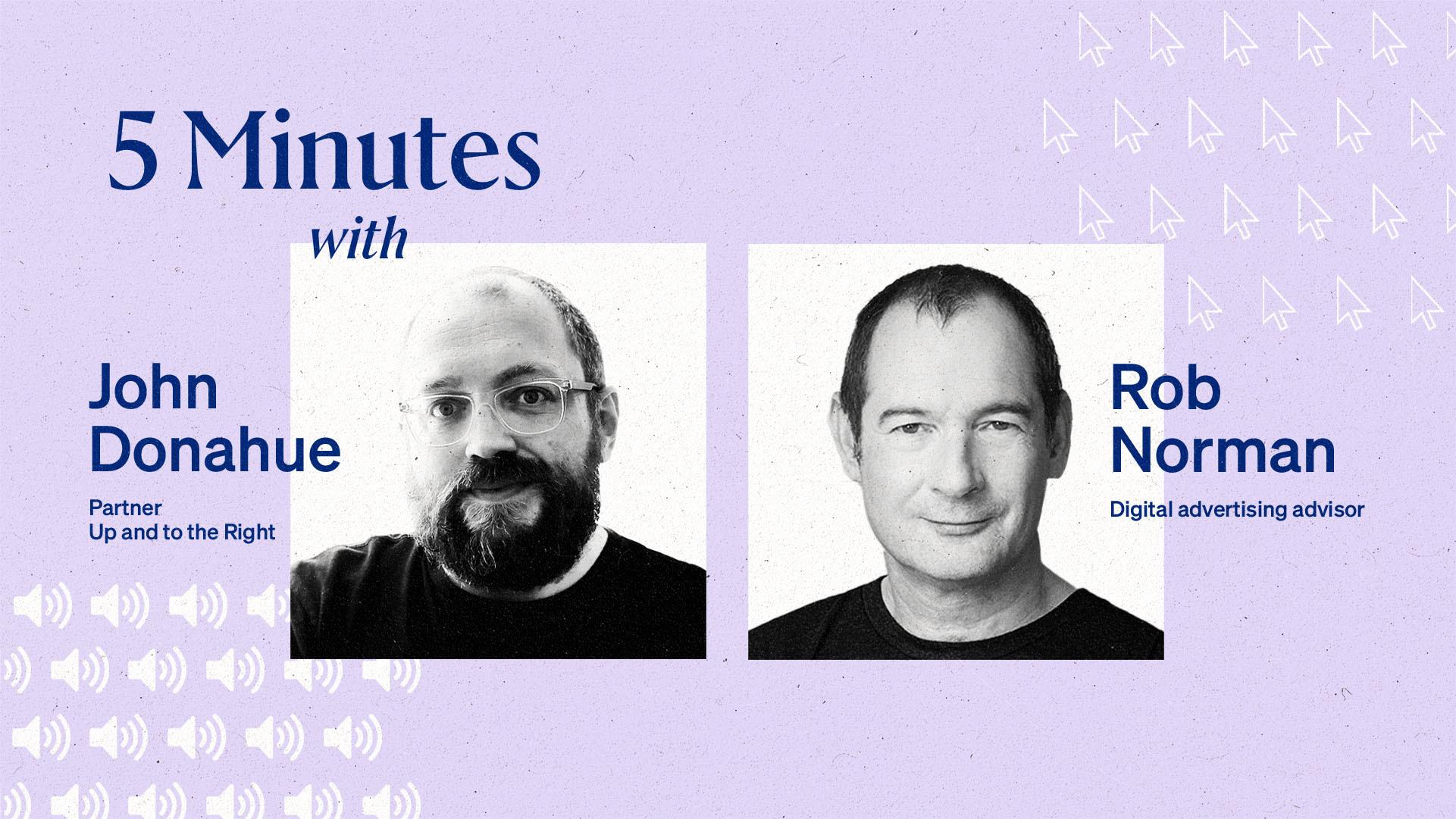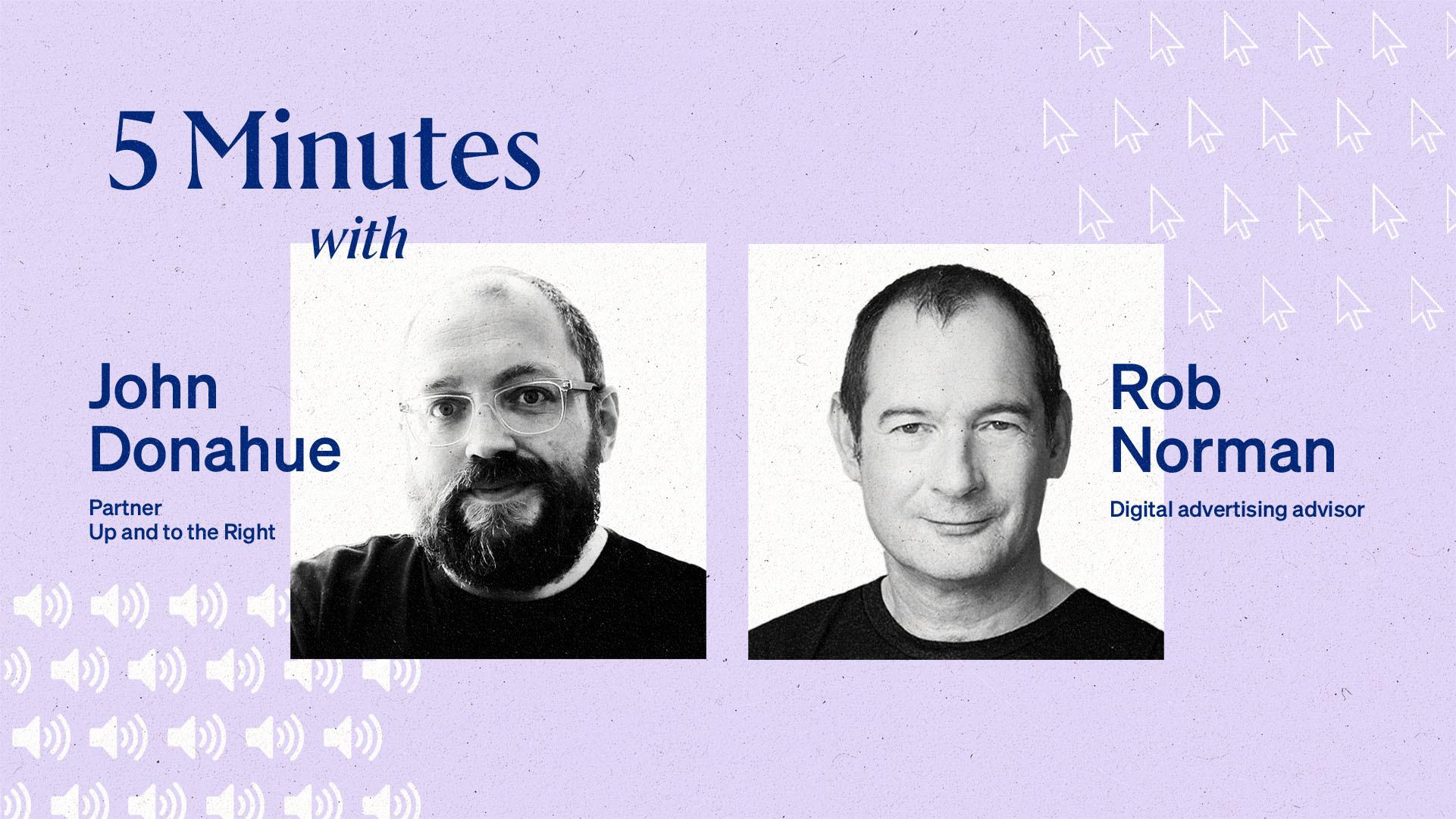5 minutes with John Donahue and Rob Norman


We’re now about a quarter of the way into Google’s plan to fully phase out third-party cookies.
Coming off the IAB Tech Lab’s recent assessment of Google’s Privacy Sandbox, which a Google spokesperson told Marketing Dive “includes dozens of fundamental errors, inaccuracies and instances of incomplete information,” we spoke with two digital advertising veterans about the Sandbox, life after cookies and how history could be repeating itself.
Both John Donahue, partner at programmatic consultancy Up and to the Right, and Rob Norman, digital advertising advisor and former CEO of GroupM North America, have worked since the early days of the internet at places like BBC News, Comscore and Omnicom.
The following interview has been edited for length and clarity.
What are your thoughts on the Privacy Sandbox?
John Donahue: We have a self-inflicted wound here. There were practices in place within the digital advertising ecosystem that created the consumer concern on privacy. So fundamentally, the privacy conversation was created by the advertising industry and the practices that exist. Regulations such as GDPR [General Data Protection Regulation], CCPA [California Consumer Privacy Act] and such are requiring us to change some of our fundamental infrastructure.
Privacy Sandbox is a solution that takes a similar approach to Meta — [that] a certain amount of data can be used to cohort but does not democratize the targeting back into the open internet [and] leaves it within a walled garden.
The Trade Desk has open-sourced UID2 [Unified ID 2.0] [to] democratize that back into the open internet. And that allows a more robust one-to-one solution that is not held back in the walled gardens. It allows you to have a chain of culpability.
Rob Norman: If you zoom out to 10,000 feet, we are moving from a world [around] a non-consented universal identifier in the cookie (although parenthetically is that really true, given Firefox and Safari) to a consented and non-universal identifier. And so, advertisers have to work within those constraints, which are legitimate from a consumer-protection point of view.
There’s a duality to this. One is working with the constraints of the identifiers that are available, and the other is how responsible you are in terms of the experience you want to create for consumers. I’m kind of glad in a way that there’s a tension over this because Google is being held to account by the IAB, is being held to account by The Trade Desk.
But on the other hand, Google is quite rightly saying that what we’re not trying to do is create a direct and exact replacement for the cookie and a direct and exact replacement of all the processes in online advertising that created the issue in the first place. My sense is the way this will settle down is that we’ll have a drop from whatever 100 [percent efficiency] looks like today to 65 or 70 when people try and do the old things in a new way.
But it will climb back into the 80s and 90s when people adjust what they’re doing, adjust their expectations and their ambitions to a newer world order. And there’s a kind of history in that sort of dynamic working.
Donahue: There is history in what Rob said there that’s very important for us to realize because the key to being smart, for me, in digital is be stupid enough to not be dumb. This has already occurred so let’s look to the history and understand what we’re looking down the gun of.
And then the goal becomes ‘[let’s] help that transformation’ from a workflow perspective to make those changes to get to that 90% quicker.
Norman: And there’s a weird aspect to this of course as well because when you hear people discussing this, it’s almost as if the point of departure was [that] the cookie was perfect in terms of its ability to identify people accurately and to be used for targeting optimization and attribution purposes. And we’re going from this perfect world to this other world, which feels much less perfect.
Of course, the cookie was never perfect in the first place. There’s an argument that says dependency on cookies was a lazy proxy for really thinking about how consumers identified and how cohorts are identified.
Maybe this forcing function of not having a cookie and having to think more widely about the role of identifiers and cohorts gets us to a better place in terms of our craft, rather than relying on something that wasn’t all that good in the first place.
To hear more from Rob and John, listen to this episode of The Current Report:
As companies experiment, how long will it take for them to really adapt and get where they want to go?
Norman: They’re going to be motivated to do that. The way that money flows in advertising is to the best performance of the next marginal dollar of expenditure. When one piece of it gets compromised, what can happen is that money flows out of that channel and into another channel.
The advertising business is dependent on an active relationship between publishers and consumers, because it’s upon that active relationship that we rely for distributing messaging.
One of the things that I’ll be urging people that I work with, and [that] I hope other people will do, is to say it’s really important that you work your way through these new dynamics in programmatic, not just to make the channel work on its own, but to ensure that the funding keeps going to the media that matters to all of us.
Donahue: I couldn’t agree more. And I think there are realities that exist now. iPhone users, for the most part, are relegated to this already. Safari [and iOS] do not allow for persistent cookie ads.
And it’s like watching a fish climb out of the water and wiggle on the sand as opposed to taking the time to grow legs and walk and just sort of change how it needs to evolve in order to survive. We’re at this great precipice of ‘evolve or die.’ These are the moments that I love and enjoy because it will create that tension to force that evolution.
But the reality is that people that are freaking out about this coming, it’s been here, it’s happened. You’ve been sort of living a lie to date if you haven’t thought about growing legs and growing some lungs.
Where do we go from here? If we were talking a year from now, what would it look like? How does it play out? What do brands do?
Norman: My sense is that every advertiser is doing a signal audit of its business about what it knows about its customers and what it knows about its own sales and demand dynamics, and thinking about how to harness them to inform their interest in the bidstream. To me [that’s] something they should have been doing anyway.
But the urgency for doing that is greater than it ever has been. I suspect that people harnessing those signals correctly will result in a situation where they have a more valuable and higher-fidelity set of signals than the cookie ever was.
The Current is owned and operated by The Trade Desk, Inc.